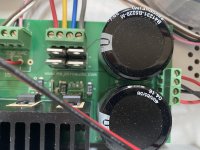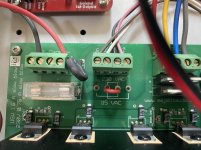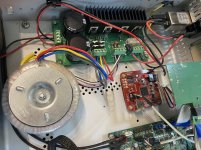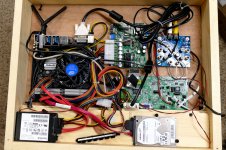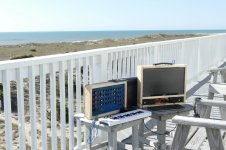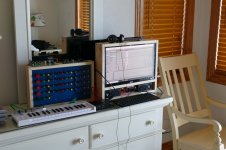I hope I am asking the question in the right forum. I bought recently a second hand audiophile server made by a small Dutch company. I do not have documentation but I could identify immediately that they are of very good quality. The server uses a Jetway embedded low power mini ITX board and a custom-made linear power supply with a toroidal transformer.
As the current CPU is not very recent, my idea would be to upgrade this part of the system in the future. The issue I have is that I don't know if I can go towards a higher power Mobo/CPU. I managed to identify the transformer and it is a 120va 2x12V.
I am new to this stuff and trying to learn, but is there a way I can identify the maximum load the power supply can provide. The current CPU is a Celeron 10W TDP.
As the current CPU is not very recent, my idea would be to upgrade this part of the system in the future. The issue I have is that I don't know if I can go towards a higher power Mobo/CPU. I managed to identify the transformer and it is a 120va 2x12V.
I am new to this stuff and trying to learn, but is there a way I can identify the maximum load the power supply can provide. The current CPU is a Celeron 10W TDP.
Unsure if you have any measurement equipment, but it would be good to know the actual current flowing from those "2X12V" windings. That's good data to have for the current situation.
You can always try to find a mobo / processor combo where the proc is maybe an i5 upgrade from the Celeron, with the same or similar TDP. Look up your Celeron performance on PassMark Software - CPU Benchmark Charts. Do the same for your candidate i5 replacement - you'll see the TDPs listed there.
How many simultaneous audio streams do you need from this server? You might be surprised at what the OEM's choice of the Celeron can do.
You can always try to find a mobo / processor combo where the proc is maybe an i5 upgrade from the Celeron, with the same or similar TDP. Look up your Celeron performance on PassMark Software - CPU Benchmark Charts. Do the same for your candidate i5 replacement - you'll see the TDPs listed there.
How many simultaneous audio streams do you need from this server? You might be surprised at what the OEM's choice of the Celeron can do.
The power supply may use off the shelf linear regulator chips, and possibly a switch mode pre regulator to get 5 volts from a 12 volt transformer secondary. Get the part numbers off of these chips and look up their specs.
These chips usually go into current limiting if overloaded and will cause all sorts of odd behavior in a computer board, including possibly damaging the CPU chip itself if one voltage source shuts down unexpectedly. I had a core i7-7700T which was underclocked to Intel's 25 W TDP specs fry possibly due to such an event. Intel did replace the chip under warranty.
Post a picture of the power supply and maybe we can better guess it's power capability, but part numbers are generally more helpful.
These chips usually go into current limiting if overloaded and will cause all sorts of odd behavior in a computer board, including possibly damaging the CPU chip itself if one voltage source shuts down unexpectedly. I had a core i7-7700T which was underclocked to Intel's 25 W TDP specs fry possibly due to such an event. Intel did replace the chip under warranty.
Post a picture of the power supply and maybe we can better guess it's power capability, but part numbers are generally more helpful.
Hi, thanks for the answers! To answer some of the questions:
- I do not have measurement equipment
- Just one audio stream but I am using Roon DSP to oversample to DSD 256. I understood the Celeron CPU cannot cope with this operation. The current CPU is a Celeron N2930
- I will open the box tomorrow morning and post pics.
- I do not have measurement equipment
- Just one audio stream but I am using Roon DSP to oversample to DSD 256. I understood the Celeron CPU cannot cope with this operation. The current CPU is a Celeron N2930
- I will open the box tomorrow morning and post pics.
Last edited:
The ST Microelectronics LM317T chips in that board are rated for 1.5 amps each. It does look like at least two of them are wired in parallel, possibly three.
If the board has two outputs, 5 volts and 12 volts, then there are three logical possibilities. A 12 volt and a 5 volt output, each at 3 amps, or a 12 V, 1.5 A and a 5 V, 4.5 A output, or a 12 V 4.5 A output and a 5 V 1.5 A output.
The most likely combination of outputs from my observation above is that there is a 5 V output for the XMOS board that could put out up to 1.5 Amps. That little board does not need that much current though. The 12 volt output could source 4.5 amps if all three chips are perfectly matched. 4 amps would be a more realistic limit.
It appears that you have a motherboard that runs from a single positive voltage supply. You state that it is 12 volts, and that is possible, but such motherboards are rare. There were some intended for car computers a long time ago, but they were relatively low powered and vanished from the market maybe 10 years ago. If your motherboard does run at 12 volts, it can draw maybe 50 watts total from that supply on 12 volts. Any replacement motherboard would also need to be able to run from the same source.
Jetway still makes motherboards that run from a single 12 volt supply. Most have the CPU soldered directly onto the board, so it is not user upgradeable. Your board may be the same way.
Their newer JNP-691 boards use a 6 W TDP dual core Celeron 3350 or a 6W TDP quad core Pentium 4400. The total power needed from the 12 volt supply is not stated in their manual, but it may be lower than what you have now. I have no idea if their new stuff is physically or electrically compatible with your existing setup.
NP691 :: JNP691 :: Intel Apollo Lake Pentium N4200 Celeron N3350 Pico-ITX Motherboard :: JETWAY COMPUTER CORP.
My latest portable computer systems need more processing power than these boards can give, so I have been using mini-itx board with user swappable 35 watt TDP chips like the core i7-7700T they can be powered from 12 volts by one of these units.
picoPSU-90 12V DC-DC ATX power supply
Mini-box also has a bunch of small motherboards for applications like yours, including some Jetways. I have never used any of their motherboards, but I have used the 90 watt pico psu power supplies with good results.
If the board has two outputs, 5 volts and 12 volts, then there are three logical possibilities. A 12 volt and a 5 volt output, each at 3 amps, or a 12 V, 1.5 A and a 5 V, 4.5 A output, or a 12 V 4.5 A output and a 5 V 1.5 A output.
There are two outputs - 12v to the motherboard and 5v to the JCAT USB card.
The most likely combination of outputs from my observation above is that there is a 5 V output for the XMOS board that could put out up to 1.5 Amps. That little board does not need that much current though. The 12 volt output could source 4.5 amps if all three chips are perfectly matched. 4 amps would be a more realistic limit.
It appears that you have a motherboard that runs from a single positive voltage supply. You state that it is 12 volts, and that is possible, but such motherboards are rare. There were some intended for car computers a long time ago, but they were relatively low powered and vanished from the market maybe 10 years ago. If your motherboard does run at 12 volts, it can draw maybe 50 watts total from that supply on 12 volts. Any replacement motherboard would also need to be able to run from the same source.
Jetway still makes motherboards that run from a single 12 volt supply. Most have the CPU soldered directly onto the board, so it is not user upgradeable. Your board may be the same way.
Their newer JNP-691 boards use a 6 W TDP dual core Celeron 3350 or a 6W TDP quad core Pentium 4400. The total power needed from the 12 volt supply is not stated in their manual, but it may be lower than what you have now. I have no idea if their new stuff is physically or electrically compatible with your existing setup.
NP691 :: JNP691 :: Intel Apollo Lake Pentium N4200 Celeron N3350 Pico-ITX Motherboard :: JETWAY COMPUTER CORP.
My latest portable computer systems need more processing power than these boards can give, so I have been using mini-itx board with user swappable 35 watt TDP chips like the core i7-7700T they can be powered from 12 volts by one of these units.
picoPSU-90 12V DC-DC ATX power supply
Mini-box also has a bunch of small motherboards for applications like yours, including some Jetways. I have never used any of their motherboards, but I have used the 90 watt pico psu power supplies with good results.
There are plenty of server grade motherboards from supermicro that work with single 12v supply. I'm pretty sure asrock and gigabyte are releasing similar boards as well. I'm waiting for these for my new media box: ASRock Industrial - IMB-1223-WV
Thanks for the input. In fact, I identified the motherboard currently used. It is Jetway nf9m 2930. It is feeded on the 2-pin +9V ~ +36V Alternate Power connector (Molex 5566-2) with two wires coming from the power supply (GND and power).
I am not a big power supply expert, but I understand the linear power supply currently in there is of great quality for audio and replacing it would cost a significant amount. Hence I want to make sure that if I plug in another motherboard/cpu they can reuse the existing power supply. What i am not sure if I need to stay in embedded CPUs (so limited to Celeron and co), or that I can also plug in a socekted motherboard allowing me to use low power CPUs like the Core i3, i5, i7 T variants.
I am not a big power supply expert, but I understand the linear power supply currently in there is of great quality for audio and replacing it would cost a significant amount. Hence I want to make sure that if I plug in another motherboard/cpu they can reuse the existing power supply. What i am not sure if I need to stay in embedded CPUs (so limited to Celeron and co), or that I can also plug in a socekted motherboard allowing me to use low power CPUs like the Core i3, i5, i7 T variants.
I don't mean to rain on your parade, but an LM317T-based regulator is not particularly high end, and the benefits (for hifi audio) of using it to power a computer are contentious. IMO a linear power supply is far more worthwhile just for powering your WaveIO USB interface.I understand the linear power supply currently in there is of great quality for audio
Yes, I understand this is highly CPU intensive, and people on the Roon forum typically use an i7 processor in such cases, possibly with the offload-to-GPU function enabled as well.I am using Roon DSP to oversample to DSD 256
Yes, I agree with Tubelab_com's estimate, and this is a modest amount of power for a computer. So if you upgrade to a socketed mini-ITX motherboard, with an i7T processor, I estimate you will be over this 50W. And if you add an external graphics card this will push you even further beyond your power supply's capacity.The 12 volt output could source 4.5 amps if all three chips are perfectly matched. 4 amps would be a more realistic limit.
...
If your motherboard does run at 12 volts, it can draw maybe 50 watts total from that supply on 12 volts.
So I would use a conventional switchmode computer power supply, possibly the smaller SFX form factor.
If space is at an absolute premium, use a picoPSU (as Tubelab_com suggested) in combination with an external 12V "brick" SMPS.
So if you upgrade to a socketed mini-ITX motherboard, with an i7T processor, I estimate you will be over this 50W.
Here are some pictures of a crude portable PC that I built in a wood box back in 2017. It uses components similar to what's described above.
The motherboard is an ASRock mini-ITX H270M-ITX/ac with a core i7-7700T which is rated at 35W TDP. 35W is not the maximum that the CPU will draw, it is a weighted average. Under peak loads the CPU "turbo's" its clock speed up until the maximum core temperature is reached, then "throttles" back to stay around 35 W. This system uses the on board video and audio which are sufficient for the intended mobile video, and audio editing, and music creation applications. An external USB sound module is used for critical sound quality applications.
There are two SSD's, one is used for booting and program storage. The other is for data storage. All modern SSD's run from the 5 volt supply only and draw less than a watt when not being accessed. There is a 2 TB conventional spinning Samsung. It is run in standby mode (not spinning, and well under a watt). It is for pictures, video and music.
The green board in the center is a power supply that takes a 6 to 30 volt source, and produces all the voltages needed for a typical "ATX" motherboard. It came from mini-box and claims an efficiency of over 95%. I run this computer on a large 24 volt 5 amp brick, or a 22 volt 5000 mAH LIPO battery intended for a model helicopter (not present when these pictures were made).
M4-ATX, intelligent ATX automotive power supply, 6/30V - power your PC in a car.
The large green board is the board from a 19 inch ACER display that I removed from it's plastic case. The LCD panel is on the other side of the box.
The blue board is a TI class D amplifier evaluation board rated at 10 WPC from a 12 volt supply. It feeds the pair of Tang Band speakers on the front. Headphones are driven directly from the motherboard's headphone output.
This system IDLES at 27 to 35 watts, about 10 of that is consumed by the display. A simple task like playing a 1080 video streamed from Youtube over WiFi pushes it to around 50 watts. Running a DAW like Ableton Live can push the average power demands up near 75 watts and sometimes over 100 watts. Loading up Ableton with a bunch of software music synthesizers, can get the the CPU utilization up into the 60% to 80% range causing peak demands of over 125 watts. All measurements were done by measuring the actual current and voltage on the 24 volt input.
This shows that a 35 W TDP chip in a conventional motherboard can still eat a lot of power, depending on the CPU load. If your power supply can not source the required power without limiting there will be erratic operation and possibly damage to the system. This possibly led to the death of the CPU chip in this system. My Amazon sourced 24 volt brick kept limiting, or shutting down unexpectedly when I attempted to render a 1080 video on this computer, sometimes it worked, sometimes, it crashed, one day it just died. The CPU was dead. I have been using a Meanwell 150 watt 24 volt supply for power since then with no issues.
The pictures show what's inside the box, and it's use on a vacation trip in 2018. It is being used with a DIY music synthesizer, an external music keyboard and audio interface that runs from the USB port consuming another 5 watts .
A modern CPU needs several different supply voltages, some at a very high current. The core voltage is usually in the 1 volt or under range, with currents in the 10's of amps. The memory chips run from 1.2 to 1.7 volts, and most of the external I/O runs on 3.3 volts. ALL of these voltages are generated on the motherboard with switch mode regulators regardless of how you power the board.
The key to making a clean quiet audio PC involves careful separation of the "dirty" signals and supplies from the clean audio. Separating the motherboard supply from the supply that powers the audio handling stuff is key, and your device may have done that with it's power supply. Breaking all possible internal ground loops is another key, and the reason why most internal motherboard sound is limited to 50-70 db of dynamic range regardless of the motherboards "100+ db" claim. This why an external USB sound module is used in most systems.
My "box PC" plays through the on board audio for non critical situations like video editing, or just watching Youtube. In critical listening or music creation applications the headphones or powered speakers are plugged into an external USB sound module, the black MOTU box seen in all three vacation pictures. I have since upgraded to Focusrite Scarlett Solo. Both have jacks for a microphone and guitar for field recording.
Attachments
Last edited:
I don't mean to rain on your parade, but an LM317T-based regulator is not particularly high end, and the benefits (for hifi audio) of using it to power a computer are contentious. IMO a linear power supply is far more worthwhile just for powering your WaveIO USB interface.
Not my parade, but what I was told by other people. Unfortunately I am a novice and learn everyday.
Is there a way to source a better quality LPS that can feed also the motherboard? I understood this gives better results than a switched power supply, but as I say I am a novice....
Yes, apart from HDPLEX mentioned by wealas, there's also Uptone Audio and Teradak. These units are all very expensive.Is there a way to source a better quality LPS that can feed also the motherboard?
But I don't think you need them, as long as you keep DC supplies isolated on the analogue side of your digital source equipment - and allegedly that's what your WaveIO USB interface does for you. You can read about it here -
Home
Again, I advise to just use a good quality computer SMPS for the motherboard. There might (?) be some bennefit in filtering the AC line which feeds this power supply - in theory this will block any noise from the SMPS from being thrown back onto the AC line. Something like this -
FN9222
That then leaves you with a high capacity linear power supply which is only being used to feed 5V to the WaveIO. It might be worth replacing this large power supply with a modern low-noise 5V power supply, such as a TPS7A4700 regulator -
Single Rail TPS7A4700 Ultra Low Noise</br>Power Supply
or an ADM7150 regulator -
1.0uV Ultralow noise DAC power supply regulator 3.3V 5.0V 800mA - DIYINHK
in combination with a small transformer -
Hammond Mfg. - Power Transformer - (229 Series)
The 230V power cables are hanging in the enclosure, even touching the presumably clean 5V output from the PSU. The PSU uses the cheapest linear regulators. They certainly do their work, but there is nothing expensive with the PSU. The WaveIO board (99EUR) is used for SPDIF output - the SPDIF transformer output is connected to the rear SPDIF connector with two freely hanging wires (no properly shielded coax, not even twisted together), even touching the power cables. The power supply cables to the JCAT USB adapter (435EUR) are touching the 230V cables (already mentioned).
Just being honest...
Just being honest...
Yes, apart from HDPLEX mentioned by wealas, there's also Uptone Audio and Teradak. These units are all very expensive.
But I don't think you need them, as long as you keep DC supplies isolated on the analogue side of your digital source equipment - and allegedly that's what your WaveIO USB interface does for you. You can read about it here -
Home
Again, I advise to just use a good quality computer SMPS for the motherboard. There might (?) be some bennefit in filtering the AC line which feeds this power supply - in theory this will block any noise from the SMPS from being thrown back onto the AC line. Something like this -
FN9222
That then leaves you with a high capacity linear power supply which is only being used to feed 5V to the WaveIO. It might be worth replacing this large power supply with a modern low-noise 5V power supply, such as a TPS7A4700 regulator -
Single Rail TPS7A4700 Ultra Low Noise</br>Power Supply
or an ADM7150 regulator -
1.0uV Ultralow noise DAC power supply regulator 3.3V 5.0V 800mA - DIYINHK
in combination with a small transformer -
Hammond Mfg. - Power Transformer - (229 Series)
Many thanks for this detailed feedback!
One correction though - the Wave IO is currently fed by the motherboard. The 5V second feed is dedicated to the JCAT 1.1 USB card that sits above. I currently use USB and I did not test the Wave SPDIF output yet as my DAC is USB only.
I have to admit that at this stage I would love to work off the existing material otherwise the purchase was a waste of money as I might as well have started from scratch.....
- Status
- This old topic is closed. If you want to reopen this topic, contact a moderator using the "Report Post" button.
- Home
- Source & Line
- PC Based
- Discover the output capacity of PC linear power supply
